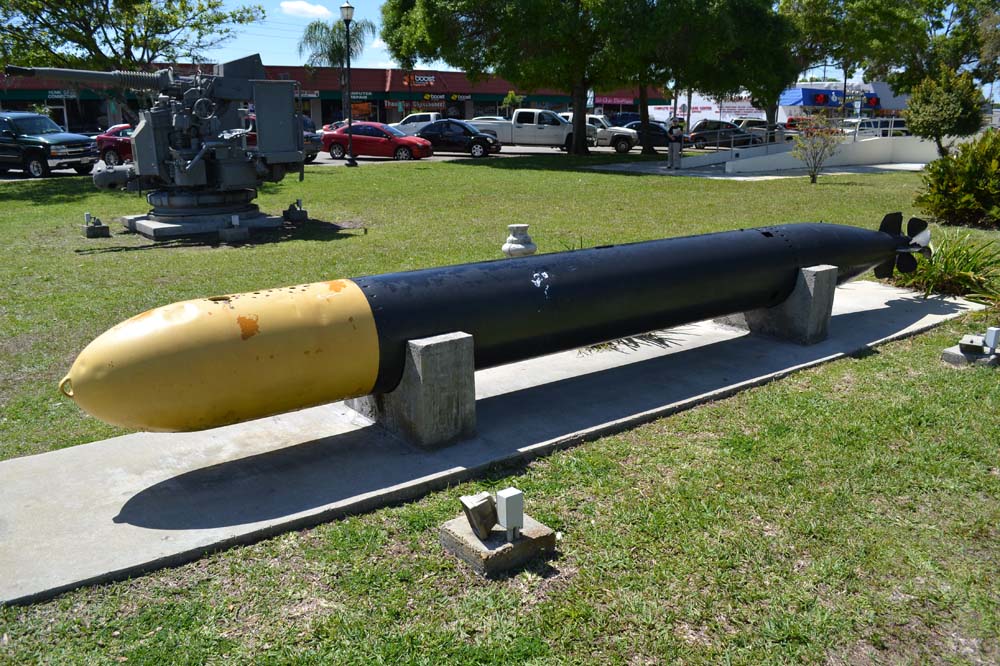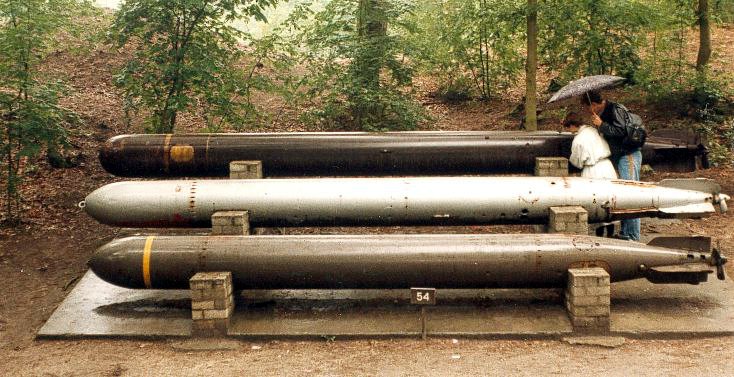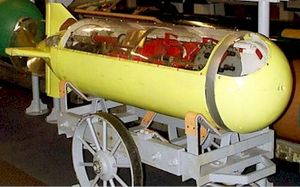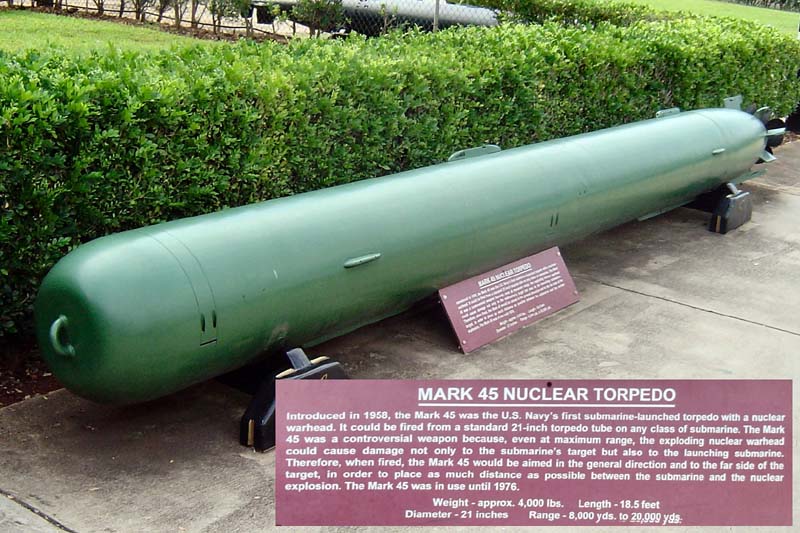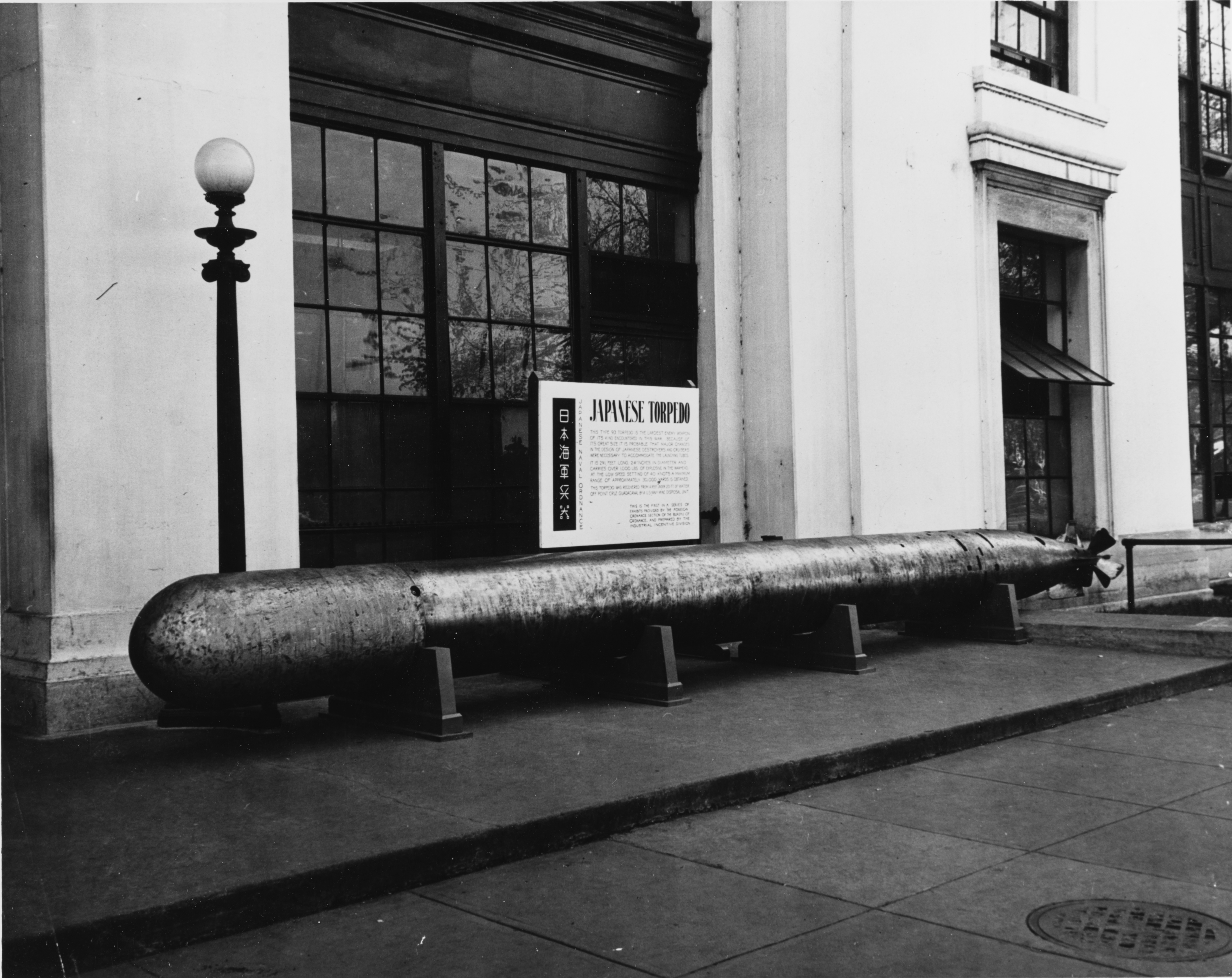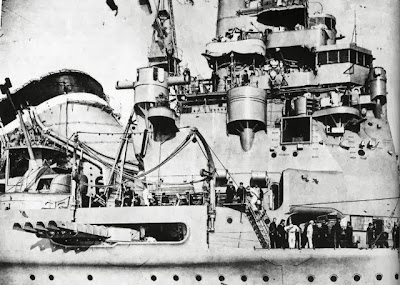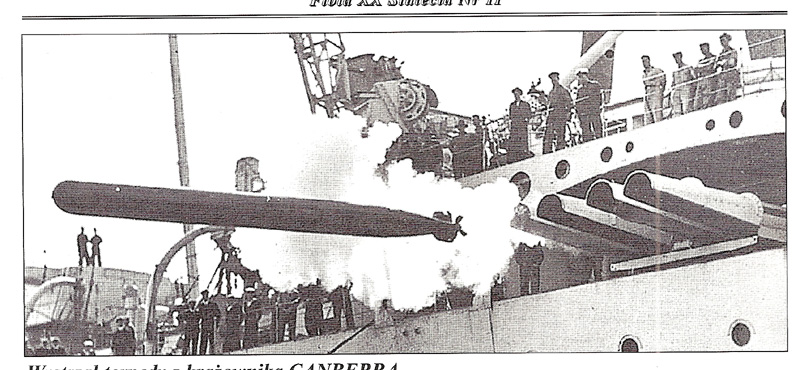PARIKRAMA
SENIOR MEMBER

- Joined
- Jan 5, 2014
- Messages
- 4,871
- Reaction score
- 185
- Country
- Location
Thread Type:
Maxi
Objective:
Introductory details about Torpedo
Introduction:
1. What is a Torpedo
" The torpedo is a self‐propelled and self‐guided underwater explosive device. "
As simple as it sounds, the part self propelled implying production of energy via a motor and fuel stored on board in a battery and self guiding implying navigating to a pre-directed target in underwater environment coupled with a explosive device which is designed to explode on contact or in proximity all of that are marvels of modern science.
Torpedo as per Encyclopedia Britannia is defined as
Well a basic schematic of a old torpedo is like this

Drawing From The January 1946 Report By The Naval Technical Mission To Japan, Index No S-91(N): The Fukuryu Special Harbor Defense And Underwater Attack Unit — Tokyo Bay.
Another example

Kaiten Type 1
Specifications:
Length: 14.5m (45ft)
Diameter: 1m (3.05ft)
Payload: 1550kg (3410lbs) HE
Total weight: 8 tonnes (8.05 long tons)
Speed/Range:
78,000m (85,332yds) at 12 knots
43,000m (47,042yds) at 20 knots
23,000m (25,162yds) at 30 knots
A more modern torpedo is like this
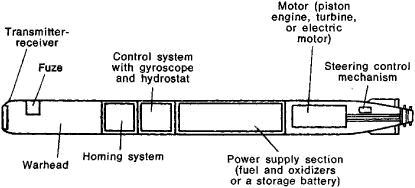
You can see a basic evolution terms of design, refinement and use of modern science, the fuel on board, to guidance to the fuse and explosives.
1.2 So what is a torpedo - ask again
2.Science behind Torpedo
2.2 Torpedo Guidance System


David Bushnell Turtle Submarine


Picture of Whitehead torpedo


Howell Torpedo
5.1 The time of "issues"
Maxi
Objective:
Introductory details about Torpedo
Introduction:
- The torpedo was the great leveller of the age of the ironclad, and the principal weapon of the U-boat forces that nearly secured victory for Germany in both world wars.
- Winston Churchill said that during the whole of the Second World War the only threat he really feared was the U-boat offensive in the Atlantic.
- In the Pacific, the torpedo was the weapon used by the US Navy to sink the majority of Imperial Japan’s warships and virtually all of her merchant fleet between 1941 and 1945, isolating her island garrisons and strangling the Home Islands themselves.
- It was torpedoes which sealed the fate of the Bismarck, crippled the Italian battle fleet at Taranto, sank most of the battleship casualties at Pearl Harbor and finally put down the largest dreadnoughts ever built.
- Hundreds of warships and tens of thousands of merchant ships have been sunk by torpedoes, or were so severely damaged that they were knocked out of action for months, if not years.
- In the modern age, the torpedo continues to be the major arbiter of potential naval actions worldwide, some 150 years after Robert Whitehead’s invention first took to the water.
- What is a Torpedo
- Science behind Torpedo
- History
- Early Torpedo Development
- World War II Torpedo
- Modern Torpedo and ASW
- Submarine Launched Torpedo
- World's deadliest torpedo
- References
1. What is a Torpedo
" The torpedo is a self‐propelled and self‐guided underwater explosive device. "
As simple as it sounds, the part self propelled implying production of energy via a motor and fuel stored on board in a battery and self guiding implying navigating to a pre-directed target in underwater environment coupled with a explosive device which is designed to explode on contact or in proximity all of that are marvels of modern science.
Torpedo as per Encyclopedia Britannia is defined as
- A cigar-shaped, self-propelled underwater missile, launched from a submarine, surface vessel, or airplane and designed for exploding upon contact with the hulls of surface vessels and submarines.
- A modern torpedo contains intricate devices to control its depth and direction according to a preset plan or in response to signals received from an outside source, as well as a device that detonates the explosive-filled warhead when it strikes its target or comes close to it.
Well a basic schematic of a old torpedo is like this

Drawing From The January 1946 Report By The Naval Technical Mission To Japan, Index No S-91(N): The Fukuryu Special Harbor Defense And Underwater Attack Unit — Tokyo Bay.
Another example

Kaiten Type 1
Specifications:
Length: 14.5m (45ft)
Diameter: 1m (3.05ft)
Payload: 1550kg (3410lbs) HE
Total weight: 8 tonnes (8.05 long tons)
Speed/Range:
78,000m (85,332yds) at 12 knots
43,000m (47,042yds) at 20 knots
23,000m (25,162yds) at 30 knots
A more modern torpedo is like this

You can see a basic evolution terms of design, refinement and use of modern science, the fuel on board, to guidance to the fuse and explosives.
1.2 So what is a torpedo - ask again
- Torpedo, an underwater, self-propelled, explosive weapon that can be launched from a submarine, a surface ship, an airplane, or a helicopter.
- It is a major naval weapon for use against warships, merchant vessels, and submarines.
- Torpedoes can also be used against fixed targets, such as harbor installations.
- Torpedoes explode below the waterline.
- Torpedoes designed for use against surface ships generally travel just below the surface of the water to avoid passing under the hull of the target.
- Those designed for use against submarines can follow and strike a target at depths of up to 2,500 feet (760 m).
- Many torpedoes travel at speeds of 40 to 50 knots.
- Some conventional torpedoes have ranges of less than 2,000 yards (1,800 m)
- Some rocket-assisted torpedoes are capable of striking targets more than 10 miles (16 km) away.
- Some torpedoes have larger dimensions and much larger range upto 50 kms or more too.
2.Science behind Torpedo
- We know so far that a torpedo is a cigar-shaped device that contains an explosive with a detonating system, a guidance system, and a propulsion system.
- So lets divide the sub parts and understand those one by one
- Most torpedoes contain conventional high explosives; a few carry nuclear warheads.
- The largest United States torpedoes carry about 650 pounds (295 kg) of conventional explosive.
- Torpedoes are detonated by contact detonators, which set off the explosive when the torpedo strikes the target, or
- by magnetic detonators, which set off the explosive when the torpedo enters the magnetic field of a steel ship. (proximity detonation)
2.2 Torpedo Guidance System
- Torpedoes are guided by any of several systems.
- The simplest is used in the straight-running torpedo, which is held on a straight course by a gyrocompass and must be aimed in the correct direction at the time it is launched.
- Acoustic, or homing, torpedoes guide themselves to their targets by sound.
- A passive acoustic torpedo follows sounds made by the target ship—usually propeller noises.
- An active acoustic torpedo is equipped with a sonar device that sends out sound waves and homes in on the echoes from the target.
- Wire-guided torpedoes are electrically guided from the attacking vessel and cannot be jammed or driven off course by the target vessel.
- Most modern torpedoes are built with more than one guidance system; most combine active and passive acoustic homing capabilities.
- The United States Mk-48 heavy torpedo has not only active and passive acoustic homing guidance but also provisions for wire guidance.
- On most new submarines torpedoes are launched through torpedo tubes along the sides near the bow.
- Older submarines have tubes located in the bow and stern.
- Surface ships launch torpedoes from tubes on the deck.
- Compressed air is used to propel the torpedo free of the tubes before its own propulsion and guidance systems take over.
- Most torpedoes are propelled by jet turbines but some use battery-powered electric motors.
- Any deviation from the set course caused the gyroscope (guidance) to apply corrective movement to the vertical rudders to use the turbine generated thrust to change directions.
- Further modifications permitted the introduction of a set angle (up to 90°) into the torpedo’s course before the steering rudders took full control.
- This feature allowed a ship to launch torpedoes without having to face broadside to the target, greatly opening up the field of torpedo tactics
- Modern torpedoes are grouped according to source of propulsive power, method of control during water travel, type of target, and type of launching craft.
- Most modern torpedo propulsion is usually by battery-powered electric motors.
- Some uses oxidizer carried on board and oxidizer mixed with fuel coupled with engine.
- Some fuel like Hydrogen Peroxide does not need any oxidizer.
- The torpedo is a descendant of the floating mine.
- To identify the historical track of the torpedo, one must first learn of its different stages of evolution.
- The earliest documentation to support the torpedos first use dates back as early as 1585 by the Dutch, where torpedoes were actually a ship packed with explosives. The ships moored alongside their potential victims.
- Floating kegs of gunpowder took the place of ships in the Battle of the Kegs at Philadelphia in 1778 during the Revolutionary War. These floating mines were uncontrollable; they had no anchor and drifted downstream with the current. The primary purpose of these weapons was to attack a ship at its most vulnerable point, the waterline.
- The torpedo in its present state, a self‐propelled and self‐guided underwater explosive device, was invented in 1866 by Robert Whitehead, a British engineer working for the Austro‐Hungarian Navy.
- In 1864 the Austrian Navy asked him to work out an idea for an explosive-carrying, self-propelled boat that could be steered from its launching site by long yoke lines.
- After building a model of the device, Whitehead rejected the scheme as impracticable and began work on an idea of his own.
- By 1866 he had a successful torpedo.
- The Whitehead torpedo was straight-running and propelled by compressed air. It was the model for most later torpedoes.
- One model of the Whitehead weapon—measuring about 14 feet (4 meters) in length and 14 inches (36 centimeters) in diameter, weighing about 300 pounds (including an 18-pound charge of dynamite in its nose)—was powered by a compressed-air engine driving a single propeller.
- Depth was controlled by a hydro static valve that operated rudders on the horizontal tail surfaces; there was no provision for lateral steering.
- Its speed was 6 knots (7 miles per hour), and its range was between 200 and 700 yards (180 and 640 m).
- In 1895 when Gyroscope was invented, slowly the whole hydro static valve system was replaced via gyroscope for better control mechanism
- The use of the early torpedo in the United States dates as far back as 1775. Torpedo development actually came via Mine warfare.
- This section will focus on connecting these dots to understand how things developed.
- David Bushnell of Connecticut possesses the title of Father of the Torpedo and Mining Warfare. His approach to underwater warfare was the beginning of American torpedo and mine warfare.
- He discovered that gunpowder could be detonated underwater.
- He designed a one-man submarine boat that would submerge and attach a gunpowder magazine to the hull of a ship.
- His submarine boat, the Turtle, was not the first submersible craft, but it was the first to employ a weapon.
- The Turtle made its pioneering first attack in 1776 against the blockading squadron of the English fleet in New York harbor.


David Bushnell Turtle Submarine
- Sergeant Ezra Lee piloted the Turtle; his attempt to fasten a 150-lb mine to the hull of Lord Howes flagship was unsuccessful.
- Due to monetary constraints, no further improvements came about.
- Robert Fulton continued the development of the floating mine in 1797.
- Fultons ideas were not intended for wartime use, but to prevent war at sea by rendering the worlds naval fleets obsolete.
- His first attempt came in 1797 during the French Revolution. The results were questionable.
- The weapon was a rudimentary locomotive torpedo.
- After several attempts to persuade the French and Dutch into purchasing the mines, Fulton sold the ideas to the English to use against the French.
- It was after many experiments for the British that Fulton realized the notion of the floating mine.
- In 1810, he perfected the floating mine with a copper case and safety lever for maintenance for the American Navy. These mines, anchored to the ocean floor, could stay in place indefinitely.
- Robert Fultons attempts at preventing war did nothing but hasten the worlds need to perfect this style of warfare.
- Robert Whitehead in 1866 designed the first automobile torpedo.
Picture of Whitehead torpedo
- It was self-propelled and would attack its target rather than wait for the enemy to come to it.
- His design was the point from which all other concept designs would begin.
- The first Whitehead torpedo used a two cylinder, compressed air engine that gave it a speed of 6.5 knots for a distance of 200 yards.
- Whitehead then developed two more models and began selling these weapons to the navies of the world.
- The first model had a length of 11 feet, 7 inches and a diameter of 14 inches. It weighed 346 pounds and had an explosive charge of 40 pounds of gun cotton.
- The second model was 14 feet in length, 16 inches in diameter and weighed 650 pounds. This model carried a 60-pound explosive guncotton
- In 1869, the US Navy established a torpedo station at Newport, Rhode Island. The station had the assignment of designing and building a torpedo using the Whitehead scheme, despite its criticized design, as a starting point.
- What NTS (Naval Torpedo Station) developed was a weapon similar to the Whitehead. It was 12 feet, 5 inches long, with a 14-inch diameter and weighed 450 pounds. It carried 80-90 pounds of guncotton and had a speed of 6-8 knots for a 400-yard range.
- The torpedo never left the test stage, because the air flask and hull did not maintain watertight integrity; the engine was also flawed.
- Corrections were made and plans were submitted to the Bureau of Ordnance for production. Only two test torpedoes were ever manufactured. The NTS Fish torpedo program terminated in 1874.
- The Howell torpedo, the first successful torpedo development program by the U.S. Navy, began in 1870. Lieutenant Commander John A. Howell created a torpedo driven by a 132-pound flywheel that spun to 10,000 revolutions per minute.

Howell Torpedo
- A steam turbine housed on the torpedo tube spun the flywheel before launch.
- The US Navy only produced 50 for tactical use.
- The Howell torpedo remained in service until 1896 when the United States decided to purchase the Whitehead and Bliss-Leavitt torpedoes.
- The United States purchased the Whitehead torpedo out of fear of falling behind in the world. Almost all other nations owned some version of the Whitehead torpedo.
- As the torpedo increased in capability, it naturally grew in size
- By 1912, the 18‐inch Mark 7 measured 17 feet in length, weighed 1,628 pounds, and carried a warhead of 326 pounds of TNT to a range of 6,000 yards at 35 knots.
- In 1914, the US navy settled on a diameter of 21 inches for most of its new torpedoes—a standard that endured for the rest of the century.
- Torpedo development during the World War I was minimal.
- Over the interwar period, Newport, under the guidance of the talented mechanical engineer and submariner Ralph Waldo Christie, pushed ahead with a number of advanced concepts.
- These included
- exotic propulsion systems using oxygen,
- hydrogen peroxide,
- electric motors to give wake-less runs;
- large, air‐dropped torpedoes;
- and magnetic exploders to increase lethality by detonating the torpedo under its target.
- As financial constraints prevented from pursuing all of these promising leads,concentration was placed on the last two.
- Introduced in 1936 was the Mark 13 air‐dropped weapon, which imposed severe speed and altitude restrictions on the aircraft carrying it.
- Also flawed was the new Mark 6 magnetic exploder. Expensive and highly secret, it entered the inventory in the 1930s, but was neither tested extensively nor issued to the fleet until 1941.
5.1 The time of "issues"
- World War II put U.S. torpedoes to the operational test for the first time, and they were found wanting.
- Following the Japanese attack on Pearl Harbor, U.S. destroyers, submarines, and aircraft were all hobbled by torpedo problems.
- American torpedo bombers at Midway suffered appalling losses as they made their low‐level attacks.
- The Mark 6 exploder frequently failed, and its backup contact pistol proved too fragile.
- The Mark 14 submarine torpedo, introduced in 1931, left a prominent wake, tended to run deep, and sometimes even circled.
- A series of distressing incidents highlighted the problems.
- Tang, one of the most successful submarines, was sunk by its own weapon.
- Two destroyers, ordered to scuttle the damaged Hornet after the Battle of Santa Cruz, fired sixteen torpedoes at the carrier without sinking it.
- In a particularly damning episode on 24 July 1943, the submarine Tinosa shot fifteen torpedoes into the largest tanker in the Japanese merchant fleet; only four exploded.
- Hurried remedial measures developed by the navy, the scientific community, and industry resolved the difficulties.
- Aircraft torpedoes were modified so that they could be dropped at much faster speeds and higher altitudes.
- The Mark 6 magnetic exploder was deactivated.
- New types of torpedoes were hurried into production, the most important being the Mark 18 electric and the homing types.
- The former, built by Westinghouse and introduced in September 1943, offered the great advantage of leaving no bubble trail.
- By 1945, 65 percent of all shots were by electrics.
- Also strikingly successful was the acoustic homing torpedo developed by Bell Labs, General Electric, and Harvard for antisubmarine work.
- Dubbed for security reasons the Mine Mark 24, the torpedo followed sound pulses to its underwater target.
- Beginning in May 1943, the air‐dropped Mark 24, nicknamed “Fido,” sank thirty‐one submarines; its surface ship variant claimed thirty‐three additional victims.
- Wartime expenditure of torpedoes was humongous.
- Historical facts list says U.S. submarines fired 14,748 torpedoes, sinking 214 warships and 1,178 merchant vessels. U.S. aircraft made 1,287 attacks, scoring 514 hits.
- Overall, about 33 percent of torpedoes fired hit their targets.
- The navy kept up with mushrooming demand by reopening its World War I facility at Alexandria, Virginia, and by contracting with private firms (Bliss, Pontiac, and Westinghouse).
- Overall production totaled 57,655 torpedoes between 1 January 1939 and 1 June 1946.
- Although the last U.S. operational use of torpedoes came on 1 May 1951, when navy planes breached the Hwachon dam in North Korea during the Korean War, development of the weapon continued apace, largely to match increasingly capable Soviet nuclear submarines.

